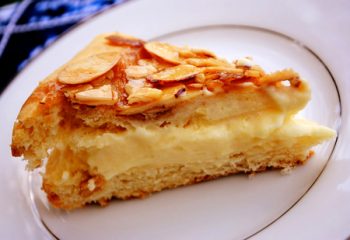Bienenstich or Bee sting cake is a German dessert made of sweet yeast dough with a baked-on topping of caramelized almonds and filled with a vanilla custard, Buttercream or cream. The cake may have earned its name from its honey topping: according to one legend, a bee was attracted to it, and the baker who invented the cake was stung.
Ingredients:
For the Filling:
2 cups milk
1/4 cup granulated sugar
2 eggs
1 tbsp flour
1 tbsp cornstarch
1 tsp vanilla
3/4 cup whipping cream
For the Base:
4 eggs
1 1/2 cups granulated sugar
1 tsp vanilla
1 3/4 cups flour
2 tsp baking powder
1/4 tsp salt
1 cup milk
4 tbsp butter
For the Almond Topping:
3/4 cup granulated sugar
1/4 cup butter
1 1/2 cup sliced or slivered almonds
4 tbsp whipping cream
Preparation:
Filling:
1. Heat the milk with the sugar until almost boiling. Stir to dissolve sugar and be careful to keep the heat at medium to low so that you don’t burn on the bottom.
2. Whisk the eggs together with the flour and cornstarch until smooth.
3. Temper the egg mixture by gradually adding about 1/2 a cup of the hot milk to the eggs, whisking constantly (otherwise you’ll end up with scrambled eggs). Then gradually stir the egg mixture into the rest of the milk in a thin stream, whisking constantly.
4. Keep stirring until mixture starts to thicken but do not let it boil. When it is thick enough to coat the back of a spoon, remove from heat and add vanilla extract.
5. Pour into a bowl. Stir a few times. Place plastic wrap over the custard, so that it is touching the custard while it cools (this prevents a skin from forming).
6. When ready to assemble the cake, whip the whipping cream until very stiff, but stop whipping before it becomes clumpy and starts to turn into butter. Stir 1/3 of the whipped cream into the cold custard. Fold the rest into the custard. Do not over mix.
Base:
1. Preheat oven to 325 degrees F (160 degrees C). Line a 9-inch (22 cm) springform pan with parchment paper.
2. In a large bowl, beat the eggs and sugar together until light and fluffy; add vanilla.
3. In a small bowl, sift together the flour, baking powder and salt; mix into the egg mixture.
4. Heat the milk and butter until very hot (not quite boiling). Add the hot milk/butter to the batter.
5. Bake 25 to 30 minutes or until cake tester comes out clean. Top with Almond Topping and allow to cool while preparing the filling.
Almond Topping:
In a medium saucepan, heat together the butter and brown sugar and the whipping cream until it just comes to a boil (should be a light caramel color). Add the almonds. Spread onto the baked cake as even as you can (this is easiest while the cake is still warm and in the pan).
Assembling the cake:
When the cake has cooled, remove cake from pan and slice in half crossways to make two layers. Place bottom layer cut side up on cake plate and spread with filling. Top with the second layer with the almond glazed side up. Refrigerate until time to serve.








